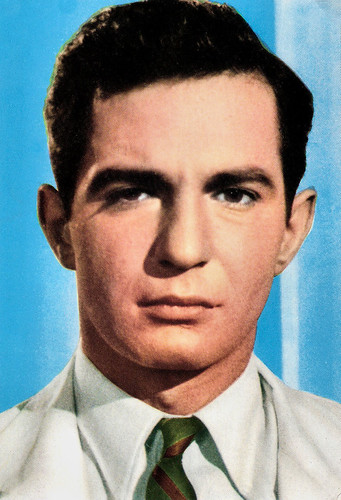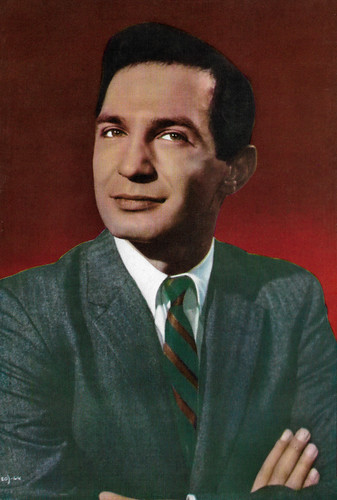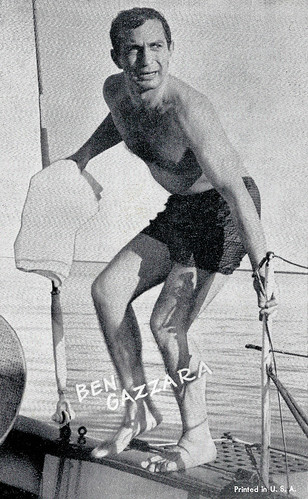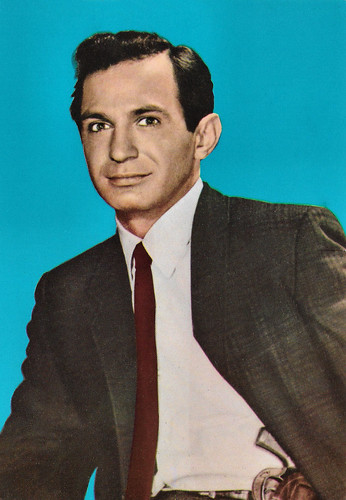
Spanish postcard by Postal Oscar Color, Hospitalet (Barcelona), no. 669. Ben Gazzara in the TV series Run for Your Life (1965-1968). The series had the Spanish title 'Alma de Acero'.

Spanish postcard by Ediciones Este, no. 155-T. Ben Gazzara in the TV series Run for Your Life (1965-1968).

Spanish postcard by Ediciones Este, no. 156-T. Ben Gazzara in the TV series Run for Your Life (1965-1968).
The Strange One
Biagio Anthony 'Ben' Gazzara was born in New York in 1940. His parents were Italian immigrants; Angelina Gazzara née Cusumano and Antonio Gazzara, a carpenter. The young Gazzara grew up in the Lower East Side, which in those days was a dangerous neighbourhood in Manhattan. He attended classes at Stuyvesant High School. After seeing Laurette Taylor in the play 'The Glass Menagerie' by Tennessee Williams, Gazzara wanted to become an actor but he decided to study electrical engineering. He gave up this study after two years when he was accepted at a prestigious drama school, The New School. There he was taught by the legendary coach-director Erwin Piscator.
Gazzara then joined the Actors Studio, where a group of students improvised a play from Calder Willingham's novel 'End as a Man'. The tale of a brutal southern military academy reached Broadway slightly changed in 1953 but with Gazzara still in the principal role. It was a star-making part for which he won a Theatre World award. Later, he also starred in 'Cat on a Hot Tin Roof' (1955) by Tennessee Williams, a production directed by Elia Kazan, and 'A Hatful of Rain' (1955) for which he was nominated for a Tony.
During his career, Gazzara was nominated for a Tony Award three times. Bigger names Paul Newman and Don Murray played those last two roles on the big screen in Cat on a Hot Tin Roof (Richard Brooks, 1958) and A Hatful of Rain (Fred Zinnemann, 1957), respectively. However, Gazzara made his film debut as the male lead in The Stange One (Jack Garfyn, 1957), the Hollywood adaptation of 'Die Like a Man'.
His next role was as the defendant in Anatomy of a Murder (Otto Preminger, 1959) with James Stewart, George C. Scott, and Lee Remick. The film was a big hit. Gazzara followed this with an Italian venture co-starring Anna Magnani and Toto, Risate di gioia/The Passionate Thief (Mario Monicelli, 1960), two Hollywood films The Young Doctors (Phil Karlson, 1961) with Fredric March, and Convicts 4 (Millard Kaufman, 1962) opposite Stuart Whitman, and then another Italian film La città prigioniera/The Captive City (Joseph Anthony, 1962) starring David Niven and Lea Massari.
None of these did much for his career, and he turned to television. He first starred in the TV series Arrest and Trial (1963-1964) and then in Run for Your Life (1965-1968) for which he received three Golden Globe nominations in 1967, 1968 and 1969 and two Emmy nominations in 1967 and 1968. In the cinema, he played the lead in The Bridge at Remagen (John Guillermin, 1969) opposite George Segal and Robert Vaughn.

American Arcade card.

American Arcade card.
Tales of Ordinary Madness
Ben Gazzara appeared several times in films directed by his friend John Cassavetes. In 1970, he starred alongside Peter Falk and Cassavetes in Husbands (John Cassavetes, 1970), which was a critical success. In 1975, Gazzara and Cassavetes appeared together in Capone (Steve Carver, 1975), in which Gazzara portrayed the notorious Chicago gangster Al Capone. Gazzara also played in Cassavetes's cult films The Killing of a Chinese Bookie (John Cassavetes, 1976) and Opening Night (John Cassavetes, 1977) with Gena Rowlands. Gazzara starred opposite Audrey Hepburn in Bloodline (Terence Young, 1979) and They All Laughed (Peter Bogdanovich, 1981).
In the Charles Bukowski adaptation Storie di ordinaria follia/Tales of Ordinary Madness (Marco Ferreri, 1981), Gazzara co-starred with Ornella Muti, but the film and his role received a mixed critical reception. Other big-screen roles in the 1980s were scarce apart from Road House (Rowdy Herrington, 1989), a Patrick Swayze vehicle that Gazzara believed out of all his films had been the most repeated on television.
In the 1970s Ben Gazarra was also active as a director. In the Columbo television series with Peter Falk, he directed the two episodes My Dead - Your Dead (1974) and Dreamboat of Death (1975). Throughout his career, Gazzara acted in theatre; he was nominated for a Tony in 1955, 1975 and 1976 respectively. Over the years, Gazzara became a much sought-after supporting actor in films. He appeared in several well-known productions such as The Big Lebowski (Joel Coen, Ethan Coen, 1998), Happiness (Todd Solondz, 1998), The Thomas Crown Affair (John McTiernan, 1999), and Dogville (Lars von Trier, 2003), starring Nicole Kidman.
In 2003, he was awarded another Emmy nomination for Best Supporting Actor in the TV Movie Hysterical Blindness (Mira Nair, 2003) starring Uma Thurman. An amazing achievement since Gazzara was diagnosed with throat cancer in 1999. He underwent chemotherapy and lost a lot of weight during the treatment. Francoise Purdue at IMDb: "If he never became the leading man his early films and stage work promised, he had a career notable for its longevity."
In 2012, Gazzara died of pancreatic cancer in New York's Bellevue Hospital Center at the age of 81. Just before his death, Gazzara was involved in the making of a film called Max Rose, in which he would play opposite elderly comedian Jerry Lewis. The film was released in 2016 and directed by Daniel Noah. For a brief period, Gazzara reportedly had a relationship with actress Audrey Hepburn, with whom he was seen together in Bloodline and They All Laughed. Gazzara was married to Louise Erickson from 1951 to 1957. From 1961 to 1979, he was married to actress Janice Rule. In 1982, he married German model Elke Krivat, with whom he remained until his death.

Spanish postcard by CyA, no. 132. Photo: MCA. Ben Gazzara in the TV series Arrest and Trial (1963-1964). The Spanish title was Arresto y Juicio.

Spanish postcard in the Postales Redcuadro Blanco series by Vikingo, Barcelona, no. 89. Ben Gazzara in the TV series Run for Your Life (1965-1968).
Sources: Francoise Purdue (IMDb), Wikipedia (Dutch and German), and IMDb.
This post was last updated on 10 May 2024.
No comments:
Post a Comment